Understanding the concepts of moving water
by Sally Bouorm | October 1, 2014 10:44 am
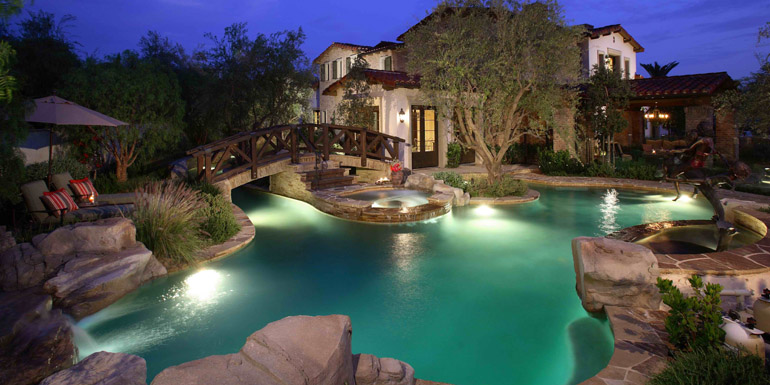 [1]
[1]By Peter Davidson
Demand for residential swimming pools with moving water (e.g. lazy rivers and current-powered exercise/therapy pools) is coming on strong. Topping the list of market trends driving this demand is the growing number of people in the ‘Baby Boomer’ demographic who are becoming more concerned with overall fitness. That said, many are turning to aquatic exercise regimens as a way to speed recovery from hip and knee replacements, ease pain from arthritis or chronic back problems, or even help fight diabetes and obesity.
Many favour current systems simply because they provide an at-home venue for exercise, thus removing the need to find public or commercial pools nearby at a local gym or community centre. They value the convenience and privacy of being able to work out at their leisure in a comfortable setting, making these exercise/therapy pools a perfect fit for their often-busy lifestyles.
At the same time, the number of homeowners looking to add greater recreational dimensions to their backyard aquatic environments is also increasing. Inspired by experiences many have had in waterparks, resorts, or community aquatic centres featuring interactive water attractions, these consumers are looking for ways to transfer those experiences to their stay-at-home resorts. Current systems enable these ambitious clients to build elaborate lazy rivers or far simpler vessels that also make use of manufactured currents for recreational purposes.
Whether for exercise and/or fun, current systems give bodies of water ‘personalities’ that cannot be achieved with static environments, as such they empower designers and builders to deliver dramatically increased levels of excitement, enhancing the joy of pool ownership.
Prime directives
For all of the appeal and power current systems have to offer, designing pools with moving water is something of an art form. Although simple in basic concept, there are specific aspects of fluid dynamics that can be surprisingly nuanced. Depending on what homeowners are looking to achieve in terms of experience, the designer/builder can configure the system and the pool itself to generate a broad spectrum of effects.
Therefore, in terms of dos and don’ts, the first and most important item is to—if at all possible—consider the current flow as an integral element in the design from the earliest conceptual stages of the project. Although current systems can be applied to virtually any body of water, having the desired end results in mind from the get-go opens the door to the greatest range of possibilities and efficient operation. However, for this to happen, designers/builders must understand what current systems are all about.
First, it is important to understand current systems are not entirely dissimilar in functional terms to how a typical swimming pool operates. In a sense, all pools have a river running through them. Water enters the vessel through return outlets creating a flow towards skimmers and other suction points.
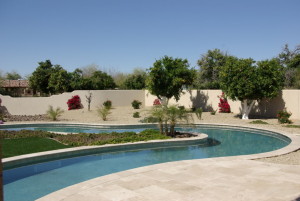 [2]
[2]One primary advantage of a dedicated current system (i.e. one that is separate from the filtration/ circulation system) is water is removed from the pool and directly returned to the vessel without having to travel through excessive reduction manifolds. Therefore, the energy needed to generate a current is not being wasted on excessive friction losses.
In terms of energy use, efficiency is further maximized when the current is introduced into a vessel designed to direct and focus the flow of water. By effectively managing the movement of water, energy consumption can be reduced by 50 per cent compared to pools that are not designed with favourable flow characteristics.
User specific
With all of the above in mind, the importance of gaining as much information as possible in terms of what the client wants and expects with respect to how they will use their pool, as well as any number of ancillary details, such as esthetics, anticipated bather load, level of fitness or even body type cannot be emphasized enough.
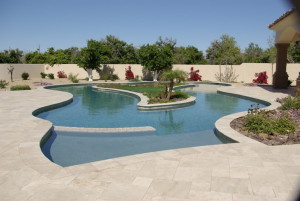 [3]
[3]Developing a detailed customer profile requires a certain level of detective work on the part of the designer and/or builder, but it is almost always well worth the time and effort. This personal dialogue not only directs the design process, but also reveals to the client various options they might not have previously considered. And, in some cases, it causes them to think more critically about what exactly it is they are hoping to achieve by way of investing in the system and the overall pool environment.
In providing a basic example, if the client’s desire is to use the pool strictly for continuous lap swimming, its depth might only need to be 1 m (3.5 ft). In contrast, however, if the homeowner’s intent is to also use the current for water walking or water aerobics, a deeper pool—perhaps with a sloped bottom where people of different heights can exercise in shoulder-deep water—would be recommended.
This information can influence the shape and size of the pool, current system placement, desired current speed, points of ingress/egress, as well as the size and configuration of islands in the case of lazy river applications. What most people, including many builders and designers, do not initially realize is depending how the project characteristics are developed, they can greatly influence the way a current behaves, which in turn directly impacts the user experience.
This is why the work of the supplier goes far beyond simply furnishing the equipment as in some cases they take on the role of a project consultant; therefore, the earlier a supplier is included in project discussions, the better they are able to advise and direct the design process relative to the application of the system.
Flow dynamics
At the heart of all of this is the fundamental fact that what is being controlled in these projects is the disbursal of energy through a body of water.
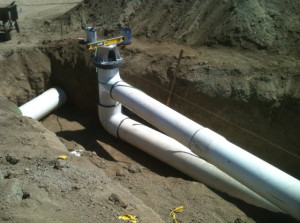 [4]
[4]For example, using a simple 9.1- x 4.5-m (30- x 15-ft) vessel, the system—in most cases—would be installed so the current runs down the length of the pool to maximize the area directly influenced by the current. This is a matter of commonsense; however, what those new to this technology typically do not realize is when the water flow encounters the wall at the other end of the pool, it rebounds and creates less vigorous secondary return flows down either side of the primary current.
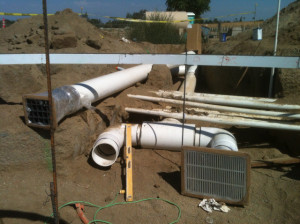 [5]
[5]Through years of application and observation, many learn to direct that effect in order to create a loop. Therefore, using the same 9.1- x 4.5-m vessel and moving the current system location over to one side—approximately 1.5 m (5 ft) from one of the sidewalls—the primary flow is now directed down one side of the pool, while the return current is concentrated down the other. Although the unit is still moving the same amount of water, using the same amount of energy, the flow characteristics have been dramatically altered to create a looping current within the pool.
In taking this concept one step further, if the pool has sweeping radius walls, rather than a rectangular design, this can further increase the amount of energy in the return flow because the water is being directed around the turn rather than slamming into a perpendicular wall, which would absorb much of the energy. (This is similar to the way a sweeping curve in plumbing is far more efficient than a 90-degree elbow; the surface governing the direction of flow simply offers less resistance; therefore, absorbing less energy.)
Finally, taking this concept yet another step further, by using what is known as the Coandã Effect, a principle of aero- and fluid-dynamics that was integral in creating lift in airplanes by managing differential pressures on opposite surfaces. This is fairly complicated science, but the idea is to design wall contours in pools with islands, water flow can be dramatically accelerated as the current bends around the pool.
Ebbs and flows
When studying flow characteristics relative to the surfaces that contain it, extremely complex dynamic characteristics can be revealed. As a result, system performance can be fine-tuned by way of shaping the vessels. This level of close study has reinforced a handful of commonsense measures that hold true across a spectrum of project types.
Again, looking at the design from a user perspective, if the desire is to simply swim against the current, builders do not have to do much more than place the system in a vessel of an appropriate depth and desired length so that it flows in a straight line at the desired speed. Design issues become more multi-dimensional only when the system is to drive a circuit around the vessel as in the case of a lazy river.
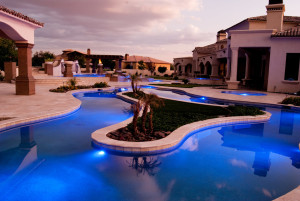 [7]
[7]In recent years, lazy rivers in both commercial and residential settings have become far more popular. On the most basic level, a lazy river provides all the benefits of exercising against a current, while at the same time, bathers can turn around and allow themselves to be swept downstream in a controlled environment.
Unfortunately, many lazy rivers are not installed or work properly; mostly those where the builder is attempting to create the flow using standard pumps to push water through long manifolds and returns distributed around the circuit. Despite the builder’s best intentions, all too often the results are dramatically energy inefficient systems that almost inevitably have dead spots.
The trouble in these situations is obvious and infuriating for everyone involved. Imagine being a homeowner who has spent their hard-earned money in hopes of owning their own lazy river, only to find when the big day comes to fire up the system, it does not work.
By contrast, a properly designed lazy river uses both the configuration of the walls and system placement to the greatest effect possible. Some require multiple river current systems to adequately generate flow around the entire circuit, while others work efficiently using only one system. In all cases, there are basic design principles that apply.
Changing the channel
First, and at a minimum, always try to avoid tight radiuses. As described above, builders can either waste tremendous energy when making water change directions or contrastingly focus that energy to enhance the flow.
Next, be aware of where the pool’s ingress/egress will be in the design. There is a tendency in far too many projects to place steps on the corners of lazy rivers. This is a huge mistake because steps in corners will absorb a tremendous amount of energy right at the point where the water should be making a smooth turn. Not only will this disrupt the lazy river effect, it can also create strong turbulence on the steps and, if strong enough, can knock bathers off their feet. This can be a problem that becomes particularly serious with the elderly or small children.
Steps should be placed in areas parallel to the flow, or even better, in widened points in the channel where the water slows down. The issue of step placement is one that can be easily accommodated in the design phase, but dauntingly expensive once the pool is built.
Another key consideration, which applies to lazy rivers as well as simpler vessels with more linear designs, is current speed. How fast the current moves is a product of the system’s flow output combined with the pool’s width, depth, and overall shape.
It is a bit of an oversimplification, but current speed can be related to walking. When the water is moving at 0.6 to 0.9 mps (2 to 3 ft/s), a person flowing downstream with the current will be moving at a slow to medium walking pace. Someone at the side of the pool can easily stroll alongside the bather and have a conversation. At 1.5 mps (5 ft/s), the bather is moving at a rapid walking pace and someone at the side of the pool would probably have to break into a trot to keep up on dry land.
When designing a lazy river, areas with varying speeds can easily be created by simply narrowing or widening the channel, or depending on the current system being used, by adjusting its output.
Finally, it is always helpful to be aware of bather load. In exercise pools designed for a single person working out against the current, it is not an issue. However, in pools that are used by a large number of bathers at the same time—such as a lazy river during a pool party—keep in mind human bodies submerged in water will dramatically absorb energy and reduce the flow. In these scenarios, it makes sense to have a robust system that can be adjusted to increase output to counteract the resistance of all the bathers being pushed by the current.
Islands and bridges
Beyond flow characteristics, lazy river pools offer ancillary benefits and features that are worth considering during the swimming pool’s early design stages. For example, these pools typically require islands, which in most cases means there will be at least one bridge leading from the ‘mainland’ to the island. These elements add huge measures of fun and enjoyment not found in more common pool configurations.
For starters, there is something fundamentally intriguing about an island. Even though it might only be a few feet away from the outside edge of pool, an island creates a different destination within the space. They are often the site of spas, lounging areas, and associated features such as waterfalls. Islands also conceal the view of portions of the river course, which adds a sense of mystery and can fuel a desire to take the journey along the river or over to the island to see what is on the other side, or just around the bend.
Lushly planted islands with rock structures, grottos or fire features can create beautiful focal points and even reflections when the water is still. They always invite visitors to cross the water to experience the environment waiting on the other side.
Bridges used to access islands offer a similar set of benefits. Although they may only span a few short feet, they represent a small journey where the visitor transitions from one place to the next. After crossing, there is an immediate sense of being in a completely separate area, perhaps a private place or one designed for small intimate gatherings.
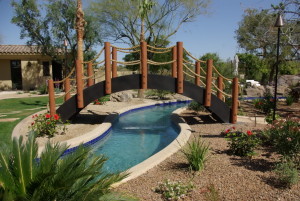 [8]
[8]From the point of view of the person floating in the river, bridges provide an added level of interest as they pass beneath them, generating a sense of movement from part of the course into another. In many designs, bridges are convenient places to locate sheeting waterfalls that douse bathers, adding even more anticipation and reward as they float downstream.
(On a practical note, it is always important to observe local building codes for the bridge height. This prevents anyone floating on an inner tube or raft from hitting their head.)
From a design standpoint, bridges offer several opportunities to create architectural structures that in of themselves become works of art. In many cases, both builders and homeowners say the bridges and/or islands become their favorite feature in the entire scene.
Great experience
Ultimately, whether they are exercise pools, lazy rivers, or more standard pools fitted with a current-generating system, the goal is to create an experience for the client. Therefore, maximizing the value of current systems and the pools that contain them is naturally going to vary from project to project. Builders need to plan accordingly and always base the project on the all-important client profile. The fact is moving water is healthy and fun. And, ultimately, this is what the aquatic experience is all about.
 Peter Davidson is CEO of Current Systems Inc., a manufacturer of high-volume, low-pressure current flow pumping systems. He has been in the aquatics industry for more than 40 years and his first patents for related pumping equipment date back to the late ’80s. He can be reached via e-mail at pdavidson@current-systems.com[9].
Peter Davidson is CEO of Current Systems Inc., a manufacturer of high-volume, low-pressure current flow pumping systems. He has been in the aquatics industry for more than 40 years and his first patents for related pumping equipment date back to the late ’80s. He can be reached via e-mail at pdavidson@current-systems.com[9].
- [Image]: http://poolspamarketing.com/wp-content/uploads/2014/10/LazyRiver51_zpse7abb30c-1.jpg
- [Image]: http://www.poolspas.ca/wp-content/uploads/2015/05/IMGP2836.jpg
- [Image]: http://www.poolspas.ca/wp-content/uploads/2015/05/IMGP2820.jpg
- [Image]: http://www.poolspas.ca/wp-content/uploads/2015/05/r1.jpg
- [Image]: http://www.poolspas.ca/wp-content/uploads/2015/05/r6.jpg
- [Image]: http://www.poolspas.ca/wp-content/uploads/2015/05/r5.jpeg
- [Image]: http://www.poolspas.ca/wp-content/uploads/2014/10/duncan-finals-81.jpg
- [Image]: http://www.poolspas.ca/wp-content/uploads/2015/05/IMGP2906.jpg
- pdavidson@current-systems.com: mailto:pdavidson@current-systems.com
Source URL: https://www.poolspamarketing.com/trade/understanding-the-concepts-of-moving-water/